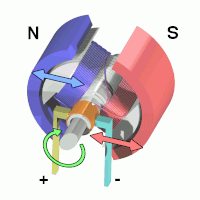
Photo from wikipedia
For hybrid-excited doubly salient synchronous machine, both the field excitation current and the d-axis current can be utilized to adjust the flux-linkage, which provides more flexible control parameters for flux-weakening… Click to show full abstract
For hybrid-excited doubly salient synchronous machine, both the field excitation current and the d-axis current can be utilized to adjust the flux-linkage, which provides more flexible control parameters for flux-weakening operation. In this paper, three flux-weakening control methods, i.e., utilizing field excitation current alone (Method I), utilizing armature current alone (Method II), and optimal method (Method III), are proposed and compared. All three methods can achieve similar torque performance in the constant-torque region. In the flux-weakening region, Method I exhibits low torque and limited operating speed range. The operating speed range can be further extended by Methods II and III. In addition, Method III can provide a higher efficiency in flux-weakening region than Method II since the copper loss of field winding can be decreased in proportion to the reduction of field excitation current. Those flux-weakening control methods are verified by experimental results.
Journal Title: IEEE Transactions on Industry Applications
Year Published: 2019
Link to full text (if available)
Share on Social Media: Sign Up to like & get
recommendations!